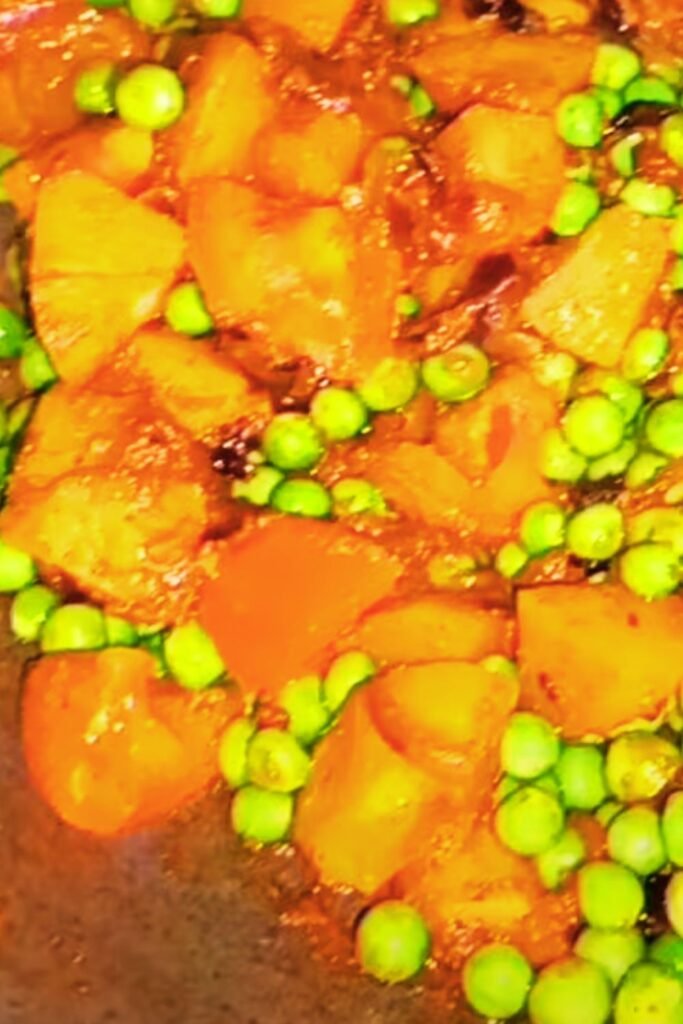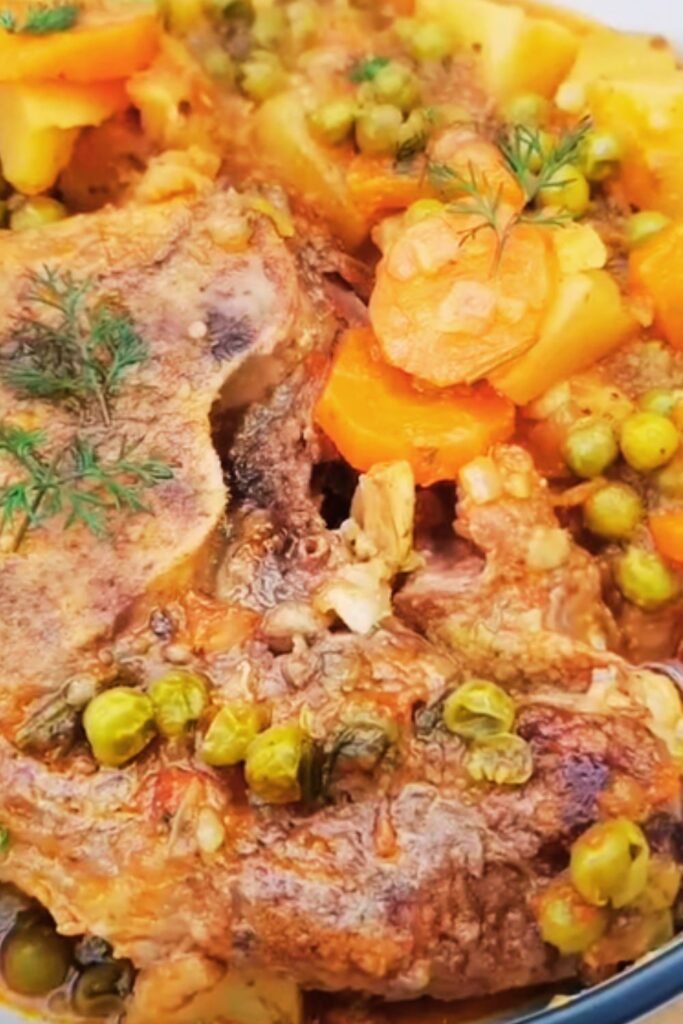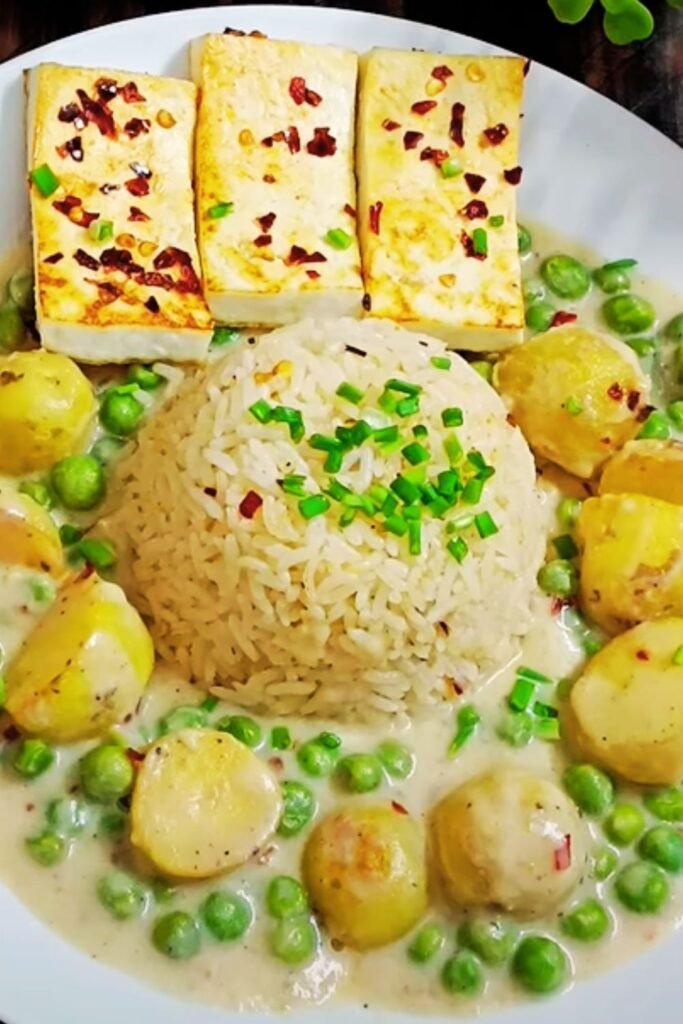There’s something truly magical about simple, humble ingredients coming together to create a dish that feels like a warm hug. Creamed peas and potatoes is exactly that kind of recipe—a beloved comfort food that has graced family dinner tables for generations. I remember standing on a kitchen stool next to my grandmother as she prepared this dish, the gentle simmering sounds and creamy aromas filling the kitchen with promises of deliciousness to come.
Today, I’m sharing my perfected version of this timeless classic. It’s a dish that transforms basic pantry and refrigerator staples into something truly special—tender potatoes and sweet peas swimming in a velvety, herb-infused cream sauce. Whether you’re looking for a satisfying side dish for your Sunday roast or a comforting main course on a chilly evening, this recipe delivers nostalgia and nourishment in equal measure.
The History Behind This Humble Dish
Creamed vegetables emerged as popular fare during the early 20th century, particularly during the Great Depression and war years when families needed to stretch ingredients and create filling meals from what was available. Potatoes and peas were often home-grown or inexpensive, making this combination particularly practical.
What began as a necessity became a cherished tradition in many households across America. The dish embodies the “waste not, want not” philosophy that defined cooking for generations before us, while also delivering remarkable flavor from just a handful of ingredients.
I’ve spent years refining this recipe, balancing tradition with modern palates. The result is creamy without being heavy, subtly seasoned to let the vegetables shine, and adaptable enough to complement almost any main dish.
Ingredients You’ll Need
For this classic comfort dish, simple ingredients combine to create something extraordinary:
| Ingredient | Quantity | Notes |
|---|---|---|
| Yukon Gold potatoes | 2 pounds (about 6 medium) | These have a naturally buttery flavor and creamy texture |
| Fresh or frozen peas | 2 cups | Fresh peas are wonderful in spring; frozen work perfectly year-round |
| Butter | 3 tablespoons | Unsalted preferred for better flavor control |
| All-purpose flour | 3 tablespoons | Creates the base for our roux |
| Whole milk | 1½ cups | Provides richness without being too heavy |
| Heavy cream | ½ cup | For luxurious texture and mouthfeel |
| Yellow onion | ½ medium, finely diced | Adds subtle sweetness and depth |
| Garlic | 2 cloves, minced | Provides aromatic foundation |
| Fresh thyme | 1 tablespoon, chopped | Brightens the cream sauce |
| Fresh parsley | 2 tablespoons, chopped | For fresh flavor and beautiful color |
| Salt | 1 teaspoon, plus more to taste | Diamond Crystal kosher salt recommended |
| White pepper | ¼ teaspoon | More delicate than black pepper |
| Nutmeg | Pinch, freshly grated | The secret ingredient that elevates the sauce |
Equipment List
- Large pot for boiling potatoes
- Colander for draining
- Medium saucepan for making cream sauce
- Wooden spoon or whisk
- Sharp knife and cutting board
- Measuring cups and spoons
Step-by-Step Instructions
Preparing the Potatoes
- Fill a large pot with cold water and add 1 tablespoon of salt.
- Peel the potatoes and cut them into 1-inch chunks of uniform size. This ensures even cooking.
- Place potato chunks in the cold salted water (starting with cold water helps them cook evenly).
- Bring to a boil over medium-high heat, then reduce to a simmer.
- Cook until the potatoes are fork-tender but still hold their shape, about 12-15 minutes. You want them cooked through but not falling apart.
- If using fresh peas, add them to the pot during the final 2 minutes of cooking. If using frozen peas, we’ll add them later.
- Drain the potatoes (and fresh peas if using) in a colander, but don’t rinse.
Creating the Perfect Cream Sauce
This velvety sauce is what transforms simple vegetables into something special:
- In a medium saucepan, melt butter over medium heat until it’s foamy but not browning.
- Add the diced onion and cook until translucent, about 3-4 minutes.
- Add minced garlic and cook for 30 seconds until fragrant, being careful not to burn it.
- Sprinkle the flour over the butter mixture, whisking constantly to prevent lumps.
- Continue cooking this roux for 1-2 minutes until it smells slightly nutty and takes on a light golden color.
- Gradually pour in the milk and cream, whisking continuously to maintain smoothness.
- Bring the mixture to a gentle simmer and cook for 3-5 minutes until it thickens enough to coat the back of a spoon.
- Season with salt, white pepper, and a tiny pinch of freshly grated nutmeg.
- Stir in the fresh thyme and half of the chopped parsley.
Bringing It All Together
- If using frozen peas, add them to the cream sauce now and cook for 2 minutes until heated through.
- Gently fold in the drained potatoes (and cooked fresh peas if that’s what you used), taking care not to break them up too much.
- Cook everything together for 2-3 minutes, allowing the flavors to meld and the potatoes to absorb some of the sauce.
- Taste and adjust seasoning as needed.
- Transfer to a warm serving dish and garnish with the remaining fresh parsley.

The Secret to Perfectly Creamed Potatoes and Peas
I’ve discovered through years of making this dish that several key techniques make all the difference:
- The potato choice matters: Yukon Golds provide the perfect balance of starch and waxiness. They hold their shape while still contributing creaminess to the dish.
- Don’t overcook the potatoes: They should be tender enough to pierce easily with a fork, but firm enough to maintain their shape when stirred into the sauce.
- Fresh herbs make a difference: While dried herbs can work in a pinch, fresh thyme and parsley add brightness that transforms this dish.
- The nutmeg secret: Just a tiny pinch of freshly grated nutmeg adds remarkable depth to cream sauces without announcing its presence.
- Seasoning the cooking water: Properly salting the potato cooking water seasons them from the inside out.
Nutritional Information
This hearty side dish provides a good balance of carbohydrates and protein:
| Nutrient | Amount per Serving |
|---|---|
| Calories | 285 |
| Carbohydrates | 37g |
| Protein | 7g |
| Fat | 13g |
| Saturated Fat | 8g |
| Cholesterol | 38mg |
| Sodium | 450mg |
| Fiber | 5g |
| Sugar | 6g |
| Vitamin A | 855IU |
| Vitamin C | 27mg |
| Calcium | 120mg |
| Iron | 2mg |
Values are approximate and based on 6 servings
Make-Ahead and Storage Tips
One of the wonderful aspects of this dish is its versatility for meal planning:
Make-Ahead Options:
- The cream sauce can be prepared up to 2 days ahead and refrigerated in an airtight container.
- The potatoes can be cooked 1 day ahead, but don’t add them to the sauce until you’re ready to serve.
- The complete dish can be assembled up to 24 hours ahead and gently reheated.
Storage Guidelines:
- Refrigerate leftovers in an airtight container for up to 3 days.
- Reheat gently over low heat, adding a splash of milk if needed to restore the creamy consistency.
- Not recommended for freezing, as the potatoes can become mealy and the cream sauce may separate.
Variations to Try
While the classic recipe is perfection on its own, I’ve developed several variations over the years that are worth exploring:
Herb-Forward Version
Add a tablespoon each of fresh chopped dill and chives along with the parsley for a garden-fresh flavor profile.
New Potato and Spring Pea Variation
Use tiny new potatoes (halved) and fresh spring peas with a touch of lemon zest for a springtime celebration.
Root Vegetable Medley
Add diced carrots and turnips to the potatoes for a colorful harvest variation with more complex flavor.
Leek and Bacon Luxury
Replace the onion with 2 thinly sliced leeks and add ¼ cup crispy bacon bits before serving for an indulgent twist.

Perfect Pairings and Serving Suggestions
This versatile dish complements numerous main courses:
- Roast chicken or turkey: The creamy sauce is perfect alongside poultry.
- Ham: The classic Easter or Sunday dinner pairing.
- Meatloaf: Another comfort food that pairs wonderfully.
- Grilled or baked fish: The delicate cream sauce complements most fish varieties.
- As a main dish: Serve in a larger portion with a side salad and crusty bread for a simple vegetarian meal.
Accompaniments:
- Fresh green salad with vinaigrette
- Crusty artisan bread
- Pickled beets or cucumber salad for a tangy contrast
- Roasted Brussels sprouts or asparagus for a green vegetable complement
Frequently Asked Questions
Can I make this dish dairy-free? Yes! You can substitute plant-based butter, unsweetened almond or oat milk, and coconut cream. The flavor will be slightly different but still delicious.
My sauce turned out lumpy. What went wrong? The most common cause is adding the liquid too quickly to the roux. Make sure to whisk constantly and add the milk in a slow, steady stream. If you do end up with lumps, straining the sauce before adding the vegetables can salvage it.
Can I use red potatoes instead of Yukon Gold? Absolutely! Red potatoes have a similar waxy texture and will hold their shape nicely. Russet potatoes, however, may fall apart too easily in this dish.
What can I do if my sauce is too thick? Simply add a bit more milk, a tablespoon at a time, until you reach your desired consistency. Remember that the sauce will thicken slightly as it cools.
Can I add other vegetables to this dish? Certainly! Small diced carrots, corn kernels, or small florets of cauliflower make excellent additions. Just make sure to adjust cooking times accordingly.
Is there a lower-fat version I can make? You can use 2% milk instead of whole milk and replace half the cream with additional milk. The sauce won’t be quite as rich but will still be delicious.
Can I add protein to make this a complete meal? Yes! Adding 1-2 cups of diced ham, shredded rotisserie chicken, or flaked smoked salmon transforms this into a hearty main dish.
Why This Recipe Works
After countless iterations, I’ve discovered why this seemingly simple dish can deliver such remarkable comfort and flavor:
- Balanced textures: The tender potatoes and sweet peas create textural interest against the smooth, velvety sauce.
- Layered flavors: Building flavor from the base with sautéed onions and garlic, then enhancing with herbs and a touch of nutmeg, creates remarkable depth.
- Proper technique: Starting the potatoes in cold water helps them cook evenly, while making a proper roux ensures a silky-smooth sauce.
- Quality ingredients: Using the best ingredients you can afford—particularly good butter and fresh herbs—elevates this humble dish.
This recipe strikes the perfect balance between accessibility and sophistication. It’s simple enough for everyday cooking but special enough for holiday meals and gatherings.

From My Kitchen to Yours
I believe food is more than sustenance—it’s memory, comfort, and connection. This dish exemplifies that philosophy. When I prepare creamed peas and potatoes, I’m not just making dinner; I’m continuing a tradition that stretches back through generations of home cooks who found ways to transform humble ingredients into meals that nourished both body and soul.
The beauty of this recipe lies in its simplicity. You don’t need fancy equipment or exotic ingredients—just good technique and an appreciation for how a few quality components can come together into something greater than the sum of their parts.
I hope this recipe finds a place in your regular rotation, perhaps even becoming a tradition in your own family. There’s something deeply satisfying about watching loved ones enjoy a dish you’ve prepared with care, especially one that carries the weight of history and memory within its creamy, comforting depths.
Give this recipe a try the next time you’re craving something homey and satisfying. I promise it won’t disappoint. And who knows? Perhaps someday, someone will stand in your kitchen, learning this recipe from you, continuing the tradition for another generation.
Final Tips for Success
- Take your time with the roux—rushing this step can lead to a raw flour taste or lumpy sauce.
- Season at every stage—the potatoes while boiling, the sauce as it simmers, and a final taste before serving.
- For special occasions, consider using half-and-half or all heavy cream for an extra indulgent version.
- The dish should be creamy but still showcase the vegetables—if it seems too soupy, simmer a bit longer to reduce the sauce.
- Rest the finished dish for 5 minutes before serving to allow the flavors to fully develop and the sauce to settle to the perfect consistency.